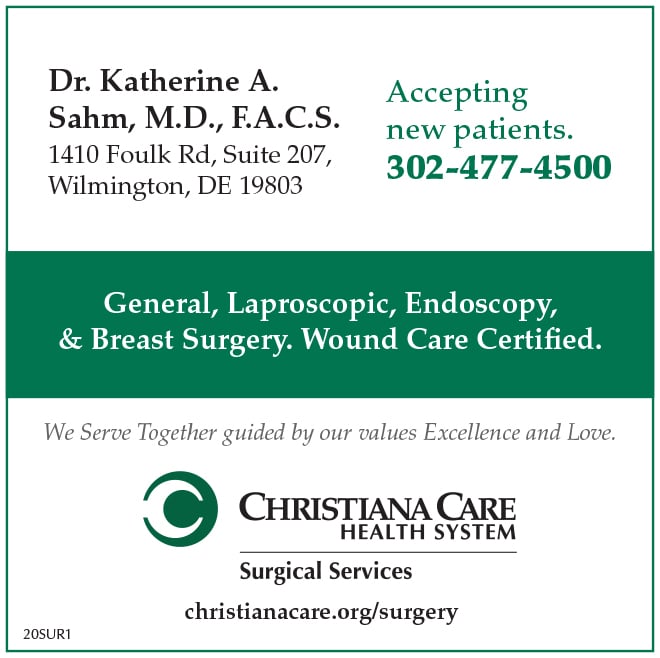Gallbladder Problems?

By Dr. Katherine A. Sahm, M.D., F.A.C.S.
Your gallbladder is a small organ that is just below your liver. The gallbladder has the important function of releasing bile into the intestines to assist with fat breakdown.
Depending on risk, such as gender, females are more susceptible to experiencing problems with their gallbladders. Other risk factors exist like age, and lifestyle.
Cholecystitis is usually the result of hard particles that form in your gallbladder which are commonly called gallstones. Gallstones can block the cystic duct, which is the tube through which the bile flows when it exits the gallbladder. This causes bile to build up and results in inflammation.
Bile duct blockage – Scarring and kinking of the bile duct can cause blockages that lead to cholecystitis.
Another reason for such symptoms to occur is a tumor. A tumor may prevent bile from draining out of your gallbladder properly, causing bile to build up and cause inflammation.
What can you do when preparing for your doctor appointment?
- Write down your symptoms: include any that may at first seem unrelated to the reason for which you made the appointment. All information counts.
- Make a list of your medications, include any vitamins or supplements you are taking.
- Take a member of your family or a friend to the appointment.
- The person who comes with you can help you to remember the information.
Write down questions to ask. For cholecystitis, some basic questions to ask your doctor include:
- Is cholecystitis the cause of my abdominal pain?
- What are the other possible causes of my symptoms?
- What tests do I need?
- Do I need my gallbladder out now or in the future?
- What is the recommendation for how soon I need surgery?
Testing:
Ultrasound – Simple test without radiation which gives the information on anatomy and shows if gallstones are present.
A HIDA Scan (Hepatobiliary Iminodiacetic Acid scan) is a scan that tracks the production and flow of bile from you liver to your small intestine and shows blockage.
Treatment:
Treatment of cholecystitis, because it may be acute in nature, could consist of a hospitalization. When hospitalized your physician will work to control the inflammation in your gallbladder. Treatment also includes:
Antibiotics – These are given to fight the infection. If your gallbladder is infected, antibiotics will be recommended.
Fasting – You may not be permitted to eat or drink at first so that stress is taken off of your inflamed gallbladder. To avoid you becoming dehydrated you may have to receive fluids intravenously through a vein in your arm.
Pain Medications – At times such medication is given to assist in controlling the pain until the inflammation in your gallbladder is relieved. Symptoms may take a couple of days to subside.
Surgery:
Because cholecystitis recurs frequently and it is unpredictable, most people with this condition, at some point in time, require gallbladder removal surgery (cholecystectomy). The scheduling of the surgery will depend on your symptoms.
Cholecystectomy is the most common surgery. It is performed using a tiny video camera mounted to the end of a flexible tube. This allows your surgeon to see inside your abdomen. The surgeon, using special surgical tools to remove the gallbladder (laparoscopic cholecystectomy) through four incisions in your abdomen, will utilize a monitor to guide the tools. An “open” procedure that requires a long incision into your abdomen is rarely required but could be necessary.
Once your gallbladder is removed, bile flows directly from your liver into your small intestine, rather than being stored in your gallbladder. You don’t need your gallbladder to live normally.
Preventing Cholecystitis:
Lose weight slowly: Rapid weight loss can increase the risks of gallstones.
Maintain a healthy weight: Being overweight increases your risk of gallstones. To achieve a healthy weight, reduce calories and increase your physical activity. Maintain a healthy weight by eating well and exercising.
Choose a healthy diet: Diets high in fat and low in fiber may increase the risk of gallstones. To ultimately reduce your risk of gallstones adopt a diet high in fruit, vegetables, lean meat, poultry, fish, and whole grains.
Dr. Sahm is experienced in treating patients with cholecystitis. You can schedule an appointment with Dr. Sahm for an evaluation by calling: (302) 477-4500.
Dr. Sahm says…
I am a native Delawarean trained in minimally invasive surgery and general surgery. I have sought out further training in wound care and hyperbaric medicine and am certified in wound care. I served two tours as a forward surgeon in Iraq in 2008 and 2010. I am a participating breast surgeon at the Helen Graham Cancer Center. I enjoy getting to know my patients and their families and caring for their surgical needs.


